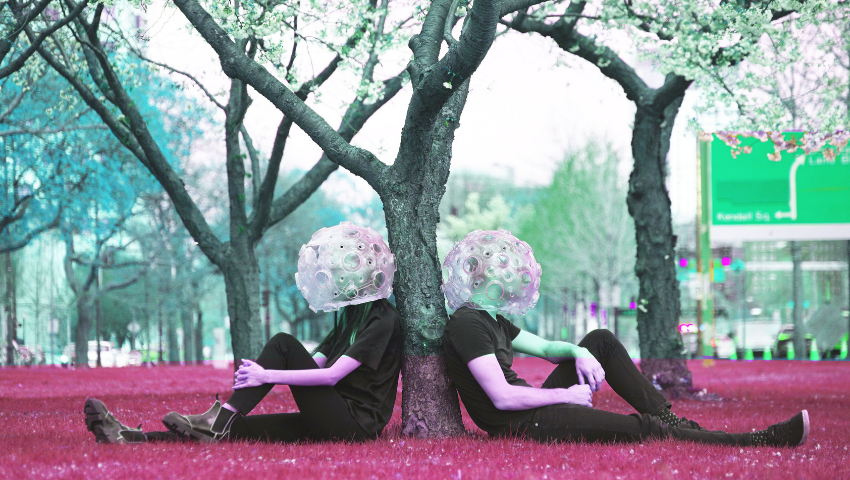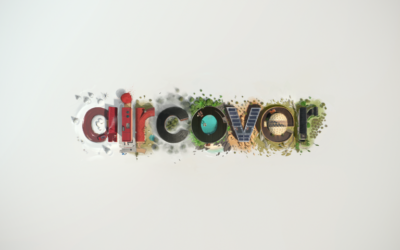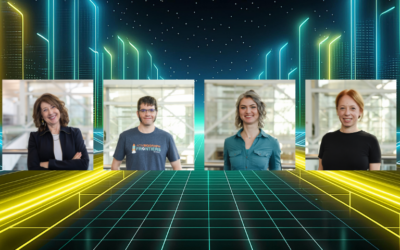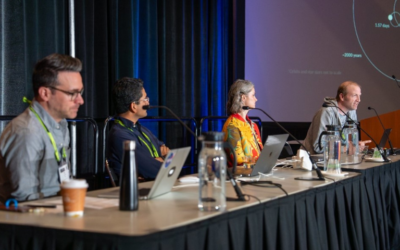TransVision: Exploring the States of the Visual Field in the Age of Extreme Augmentation © Harvard University
In today’s digital world, we are bombarded with so many messages, differing opinions, and sales pitches that it can be difficult to understand what we are consuming and how it makes us feel. Inspired by Hito Steyerl’s The Wretched of the Screen and Jonathan Crary’s Suspensions of Perception, “TransVision: Exploring the States of the Visual Field in the Age of Extreme Augmentation” is an art installation that presents three perceptual machines which question the habitual ways we interpret the visual world, intervened by digital media.
We talked with artist Jiabao Li, of Harvard University, to learn more about how she and her team developed “TransVision” and to hear what she hopes SIGGRAPH 2019 Art Gallery participants will take away from it.
SIGGRAPH: As an artist, what inspires you to blend art with digital media?
Jiabao Li (JL): Technology has provided artists new ways of expression for a long time. The invention of portable paint tubes enabled Impressionists to paint outdoors. The creation of silkscreen printing brought us Andy Warhol. The medium’s own limitation becomes the language of that medium’s form of art. To me, it’s digital media, which encompasses our everyday interactions. Technology is never neutral. It has expression in itself.
SIGGRAPH: Tell us about the process of envisioning your SIGGRAPH 2019 Art Gallery project, “TransVision: Exploring the States of the Visual Field in the Age of Extreme Augmentation.” How did today’s digital landscape influence the idea?
JL: Human perception has long been influenced by technological breakthroughs. An intimate mediation of technology lies between our direct perceptions and the environment we perceive. From news to social media, from advertising to search engines, our society is characterized by a cancerous growth of vision, measuring everything by its ability to show or be shown. Through three extreme ideal types of perceptual machines, this project defamiliarizes and questions the habitual ways in which we interpret, operate, and understand the visual world intervened by digital media.
SIGGRAPH: Talk about the symptoms of hyper-allergenic vision syndrome. What inspired your project’s focus on the social-political environment? How did the red and green environments come about?
JL: Whenever you are exposed to red, it expands in your visual field. As a side effect, the helmet generates smoke and turns into a green bubble to neutralize the red. The symptoms of hyper-allergenic vision syndrome are: tendency to overreact, politics of anger, and filtered communication landscape. Severe symptoms may include total separation and isolation from the red world.
Our modern society has observed an increase in allergies and intolerances. Hypersensitivities are emerging not only medically but also mentally. Technology has this mutual reinforcement effect that people tend to become less tolerant because they interact even less with people who have different backgrounds and opinions just because of the structure of the internet’s ability to selectively connect and filter information. Digital media as a mediator reinforces people’s tendency of overreacting through the viral spread of information and amplification of opinions, making us hypersensitive to our social-political environment.
Pushing this allergy to the extreme, I selected one nonsensical attribute of the world which is redness — we don’t know anyone who is allergic to red, but it could happen. It manifests the nonsensical hypersensitivity devised by digital media. I played a game in-between medial, political, and mental conditions around allergies. I picked the color red because it’s a very acute and even political color. The contrasting green color neutralizes and cures this “red allergy.”
SIGGRAPH: Share a bit about the development process and desired user experience. Why was it important for you and your team to deprive the viewer of all other sensory experiences when creating the tactile vision experience? What were key challenges you came across when creating “TransVision”?
JL: All three machines have both internal states and external signals. This duality allows them to be seen from the outside and experienced from the inside.
The tactile vision is the extreme version of possessing only one sense for one thing. Suppressing all other sensory experiences and leaving only one signal channel — this hyper-narrow, focused, and filtered vision — is an analog version of searching behavior on the internet. Vision works well when we have an overview of the total system, but the way we search in digital media is through little steps, from link to link — a tactile experience as we feel the landscape. We can never see it as a whole because it’s not a continuous space. Instead, we look through a pinhole and build up everything without an overview. This searching function enables us to reduce the amount of chance and encounters, so we can directly search for something in an extremely focused way and filter out everything else.
It took me a long time to experiment with the materials of tactile vision and get the soft robots to inflate evenly and not pop up. Besides, because they are wearables, they have to be not only conceptually strong, but also aesthetically pleasing and ergonomic to wear.
SIGGRAPH: Advertisements are everywhere on social media, especially those that use custom targeting. Why does the hyper-commoditized vision machine have two modes: Make Money and Spend Money? What emotions do the modes evoke in participants?
JL: The commodification of the visual field requires observers who can rapidly consume visual information. The downside of this is the extreme overload of information that has to be packed into the visual field in order to make the most out of every second when we are looking at something. The visual field becomes a commodity that has real estate value.
The “Make Money” and “Spend Money” modes create a tension between the meditative state and the consumptive state. They contemplate how augmenting the visual field with new technologies affects our relationship to the world in this particular social-economic context. The participants have to manage their time between looking at what they want and what makes money, which is already happening in everyday life.
Everyday activity becomes hampered by the fact that we have to convert vision into a moneymaking enterprise. Unfortunately, even when we have the ability to do these activities, we have to do it in a rush, because we don’t have enough capital.
SIGGRAPH: This project is relevant to all consumers of media. What do you expect SIGGRAPH 2019 participants to take away from experiencing “TransVision”?
JL: This project helps people defamiliarize and question the habitual ways in which we interpret, operate, and understand the visual world intervened by digital media. After experiencing this project, I hope the participants could look at this subtle, chronical mediation with a speculative lens.
The SIGGRAPH 2019 Art Gallery program is open to SIGGRAPH 2019 participants with an Experiences badge and above. Preview all installations below and click here to register for the conference, 28 July–1 August.
 Jiabao Li works at the intersection of emerging technology, art, and design. Her work opens questions about technology’s influence on human perception, identity, and emotion. Her research-based projects range from wearables, projections, drones, and installations to scientific experiments. She holds a Masters of Design in Technology degree with Distinction from Harvard Graduate School of Design. Jiabao’s work has been featured in Domus, TechCrunch, Yahoo, CCTV, and Yanko Design. Her work has been shown at Milan and Dubai Design Week, ISEA, CHI, SIGGRAPH, AR in Action, and PRIMER. She is the winner of the Fast Company Award, iF Design Award, Future Cities Contest, and ISWC Design Award.
Jiabao Li works at the intersection of emerging technology, art, and design. Her work opens questions about technology’s influence on human perception, identity, and emotion. Her research-based projects range from wearables, projections, drones, and installations to scientific experiments. She holds a Masters of Design in Technology degree with Distinction from Harvard Graduate School of Design. Jiabao’s work has been featured in Domus, TechCrunch, Yahoo, CCTV, and Yanko Design. Her work has been shown at Milan and Dubai Design Week, ISEA, CHI, SIGGRAPH, AR in Action, and PRIMER. She is the winner of the Fast Company Award, iF Design Award, Future Cities Contest, and ISWC Design Award.



